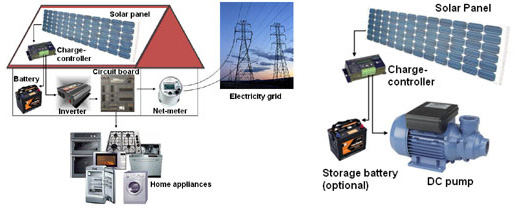+ How much energy does sunlight carry?
A. 1018 kilowatt-hours of sunlight reaches the earth's surface every year, which is 6,000 times greater than the world's annual energy demand. This means that the Sun provides world's annual energy to the earth in one hour! In another metric, on a clear day, sunlight measures a power density of 1 kilowatt per square-meter or area.
+ What are the different methods to convert solar energy into electricity?
A. Solar energy can be converted into electricity primarily in two ways: 1. Photovoltaics (PV), where sunlight is converted directly into electricity, and 2. Concentrating Solar Power (CSP) (also synonymous to Solar Thermal), heat is extracted from sunlight and converted into other forms of energy like electricity.
+ What is Photovoltaics (PV)?
A. Photovoltaics is the direct method of converting sunlight into electricity using a device known as a solar cell.
+ How does a solar cell work?
A. When semiconductors such as silicon are exposed to sunlight, they produce small amounts of electric charge (electrons and holes). A well-designed solar cell separates this charge to form a positive and negative terminal. Hence, these terminals produce a voltage, and when connected to an external circuit, cause a current flow. In this way, a solar cell in the Sun works just like a battery.

| Semiconductor structure... |
...looks like... |
...works like... |
+ How much power can a solar cell generate?
A. The power generated by a solar cell depends on the amount of sunlight it receives, area of the solar cell and its efficiency. For example, on a clear day, a 15% efficient solar cell of area 15 x 15 cm2 will produce 3.4 watts of power.
+ What is the difference between a solar cell and a photovoltaic panel?
A. A solar cell is a single semiconductor device, while a photovoltaic module consists of multiple solar cells connected together into a single unit to protect the solar cells and increase the voltage and power above that of a single solar cell. “Photovoltaic panels” and “Photovoltaic arrays” are sometimes used interchangeably, but they refer to the collective system of photovoltaic modules connected together in the system.

Solar or PV cell. |
PV module. |
PV array. |
+ How much power does a solar module generate?
A. Just as individual batteries can be interconnected, solar cells too can be connected in series and parallel connections and encapsulated into a module to output desired power.

PV module circuit. |
Equivalent battery circuit. |
+ What type of electricity does a solar module generate?
A. PV panels produce DC power, which is the same type of power produced by batteries. An inverter is used to convert this DC into AC power in order to run typical household appliances.
+ What are the potential uses of photovoltaics?
A. Due to its versatility, photovoltaic energy can be used in a wide range of applications requiring power from a couple of milliwatts for small electronics to a couple of megawatts to support entire communities. Traditionally, the most common application of photovoltaics has been for electrical loads that cannot be easily plugged into the electricity grid, either because they should be transportable – such as solar calculators, watches, etc. – or because the electricity grid does not exist at a particular location. Where the grid is located far away from a particular application, photovoltaics is being used to provide “remote power”. Examples of these applications are houses not connected to grid power, telecommunications, remote villages, water pumping and space applications. However, a recent and rapidly growing application for photovoltaics is for residential or building-integrated which are connected to the electricity grid. During the day, power is used from photovoltaics, and at night power is used from the electricity grid. A final application is utility-scale photovoltaics, in which a utility company installs a large amount of photovoltaic power. These larger systems, which are far less common than other applications, are typically installed to achieve a specific technical goal.

+ How does a photovoltaic system work? OR what are the components of a photovoltaic system?
A. A photovoltaic system mainly consists of:
1. Solar panels, which directly convert sunlight into DC electricity,
2. Charge controller, which interfaces the solar panels to the rest of the photovoltaic system and ensures maximum power extraction from the solar panels,
3. Batteries, if the system is designed to store energy,
4. Inverter, to convert DC electricity into AC if required,
5. Net-metering equipment, if the generated power is fed back into the electricity grid, and
6. Monitoring equipment, if it is intended to monitor the photovoltaic system.

Typical grid-connected home PV system. |
Typical stand-alone PV water pump system. |
+ How does a photovoltaic system provide power at night?
A. Solar cells do not directly work at night; however, typical solar systems are designed to store power generated during the day into batteries, and power can be extracted from batteries at night.
+ How long does a photovoltaic system last?
A. Photovoltaic systems are very robust and reliable, since there are no moving parts. A photovoltaic system would be expected to last in excess of 20 years. Many manufacturers have 20-year warranties on the photovoltaic modules. The electronic components can also be made reliable, since again there are no moving parts, but the warranties on these systems tend to be lower, about 5 years. If the photovoltaic system contains batteries (most stand-alone systems do and residential grid-connected do not), then the batteries will need to be replaced every 5 to 10 years.
|





